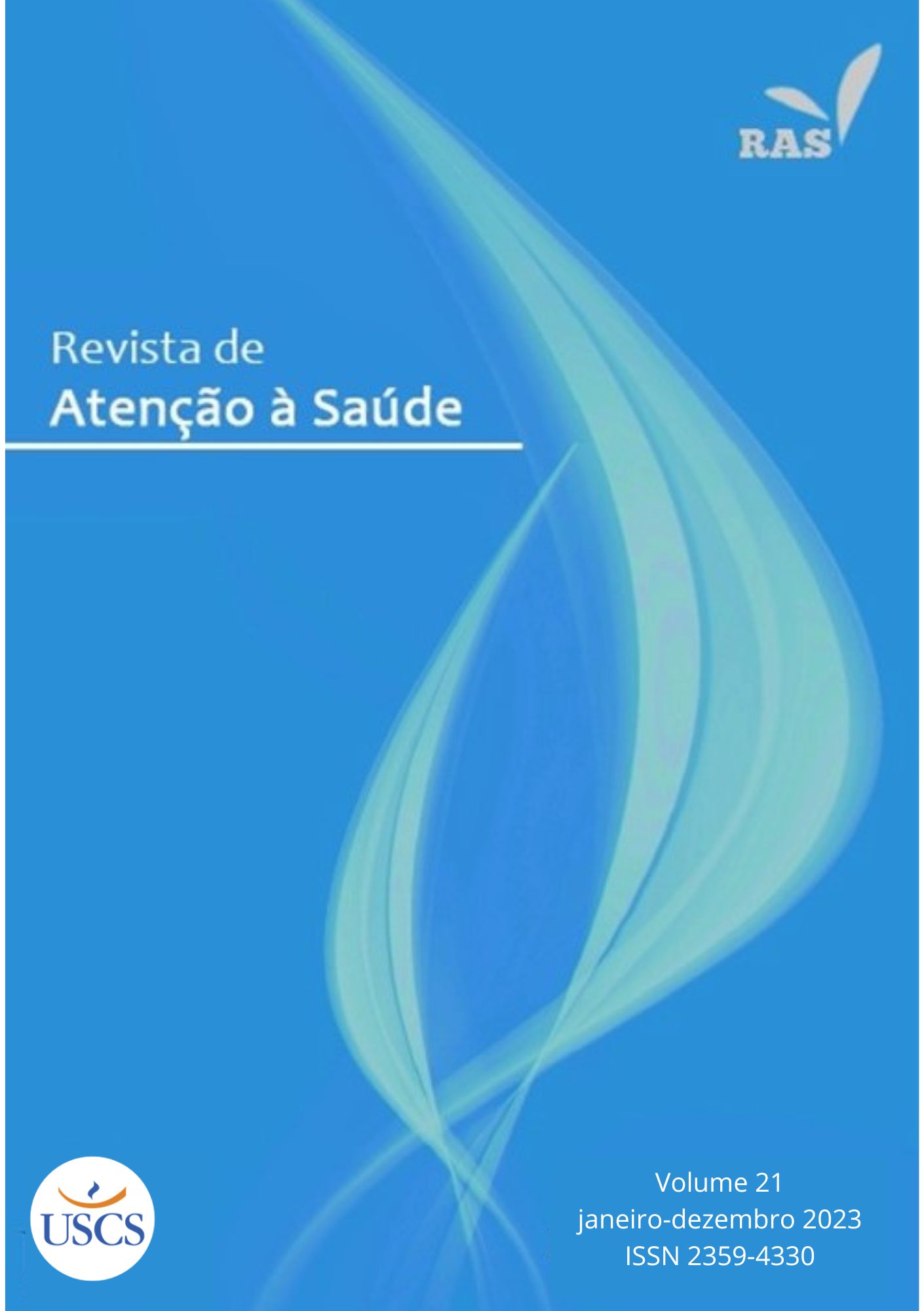CONTEXTUAL AND BEHAVIORAL FACTORS ASSOCIATED WITH DENTAL CARIES EXPERIENCE IN SCHOOLCHILDREN IN SOUTHERN OF BRAZIL
FACTORS ASSOCIATED WITH DENTAL CARIES IN SCHOOLCHILDREN
DOI:
https://doi.org/10.13037/ras.vol21.e20238941Keywords:
Adolescent., Dental caries., Cariogenic diet., Oral hygiene., Rural areasAbstract
Introduction: In addition to determining factors for the development of dental caries, such as diet and oral hygiene, the context in which individuals live has also been reflected in behavior and oral health conditions. Objective: The objective of this study was to evaluate the association of contextual and behavioral factors with the experience of dental caries in 12-year-old schoolchildren from southern Brazil. Materials and methods: The research was cross-sectional and quantitative. The participants were students from public schools. Data were collected through a questionnaire and oral examination, using the DMFT index to detect dental caries lesions. The questionnaire evaluated aspects related to oral health, such as oral hygiene habits and diet. Dentists from the municipal primary care service, previously calibrated, carried out the oral examination of students in schools. Results: 712 students participated in the survey, and 656 were examined. Schoolchildren who studied in rural areas had a 2.08 times greater prevalence of DMFT (95% confidence interval [CI]: 1.43-3.03), as well as those who did not use a toothbrush, who had 2 .14 times higher prevalence (95% CI: 1.13-4.06) when compared to its counterparts. Also, those who had visible plaque on their teeth had a 46% higher prevalence of DMFT (95% CI: 1.16-1.83) than those who did not. Conclusion: In addition to the determinants factors related to dental caries, contextual factors were associated with the experience of dental caries, stimulating strategies with the potential to minimize inequalities in oral health.
Downloads
References
World Health Organization. Global oral health status report: towards universal health coverage for oral health by 2030. Geneva: World Health Organization; 2022.
Bernabe E, Marcenes W, Hernandez CR, Bailey J, Abreu LG, et al. Global, regional, and national levels and trends in burden of oral conditions from 1990 to 2017: a systematic analysis for the Global Burden of Disease 2017 study. J Dent Res. 2020; 99(4):362–73.
Peres MA, Macpherson LMD, Weyant RJ, Daly B, Venturelli R, Mathur MR, et al. Oral diseases: a global public health challenge. Lancet. 2019, Jul; 394: 249-260.
Brasil. Ministério da Saúde. Secretaria de Atenção à Saúde. Secretaria de Vigilância em Saúde. SB Brasil 2010: Pesquisa Nacional de Saúde Bucal: resultados principais / Ministério da Saúde. Secretaria de Atenção à Saúde. Secretaria de Vigilância em Saúde. – Brasília: Ministério da Saúde, 2012.
Freire MCM, Reis SCGB, Figueiredo N, Peres KGP, Moreira RS, Antunes JLF. Individual and contextual determinants of dental caries in Brazilian 12-year-olds in 2010. Rev Saude Pública. 2013; 47 (Supl 3): 40-49.
Giugliano D, d'Apuzzo F, Majorana A, Campus G, Nucci F, Flores-Mir C, et al. Influence of occlusal characteristics, food intake and oral hygiene habits on dental caries in adolescents: a cross-sectional study. Eur J Paediatr Dent. 2018; 19(2).
Pitts NB, Zero DT, Marsh PD, Ekstrand K, Weintraub JA, Ramos-Gomez F, et al. Dental caries. Nat Rev Dis Primers. 2017, May; 3, 17030.
Petersen PE. The World Oral Health Report 2003: continuous improvement of oral health in the 21st century--the approach of the WHO Global Oral Health Programme. Community Dent Oral Epidemiol. 2003. 31 (Suppl 1): 3–24.
Wen PYF, Chen MX, Zhong YJ, Dong QQ, Wong HM. Global burden and inequality of dental caries, 1990 to 2019. J Dent Res. 2022; 101 (4): 392-399.
Momeni-Moghaddam M, Hashemi C, Fathi A, Khamesipour F. Diagnostic accuracy, available treatment, and diagnostic methods of dental caries in practice: a meta-analysis. Beni Suef Univ J Basic Appl Sci. 2022; 11 (1): 1-11.
Glick M, Williams DM, Kleinman DV, Vujicic M, Watt RG, Weyant RJ. A new definition for oral health developed by the FDI World Dental Federation opens the door to a universal definition of oral health. Int Dent J. 2016 Dec; 66(6): 322-324.
Instituto Brasileiro de Geografia e Estatística (IBGE). Panorama de cidades, Rio Grande do Sul. 2017. Brasil. Disponível em: https://cidades.ibge.gov.br/brasil/rs/rio-grande/panorama.
Engelmann JL, Tomazoni F, Oliveira MDM, Ardenghi TM. Association between Dental Caries and Socioeconomic Factors in Schoolchildren - A Multilevel Analysis. Braz Dent J. 2016; 27(1): 72-78.
World Health Organization. Oral health surveys: basic methods. 4th ed. Geneva: World Health Organization; 2013; 1-125.
Snijders TAB, Bosker RJ. Multilevel analysis: An introduction to basic and advanced multilevel modeling. London: Sage; 2003.
Watt RG, Sheiham A. Integrating the common risk factor approach into a social determinants framework. Community Dent Oral Epidemiol. 2012; 40: 289-296.
Piovesan C, Mendes FM, Antunes JLF, Ardenghi TM. Inequalities in the distribution of dental caries among 12-year-old Brazilian schoolchildren. Braz Oral Res. 2011; 25: 69-75.
Ortiz AS, Tomazoni F, Knorst JK, Ardenghi TM. Influence of socioeconomic inequalities on levels of dental caries in adolescents: a cohort study. Int J Paediatr Dent. 2020; 30 (1): 42-49.
Borges TS, Schwanke NL, Reuter CP, Kraether Neto L, Burgos MS. Fatores associados à cárie: pesquisa de estudantes do sul do Brasil. Universidade de Santa Cruz do Sul (Unisc), Santa Cruz do Sul, RS, Brasil. Rev Paul Pediatr. 2016; 34(4): 489-494.
Brasil. Ministério da Saúde. Secretaria de Atenção à Saúde. Departamento de Atenção Básica. A saúde bucal no Sistema Único de Saúde [recurso eletrônico] / Ministério da Saúde, Secretaria de Atenção à Saúde, Departamento de Atenção Básica. – Brasília: Ministério da Saúde, 2018.
Souza Júnior PRB, Szwarcwald CL, Damacena GN, Stopa SR, Vieira MLFP, Almeida WS, et al. Cobertura de plano de saúde no Brasil: análise dos dados da Pesquisa Nacional de Saúde 2013 e 2019. Cien Saude Colet. 2021; 26 (Supl. 1): 2529-2541.
Rio Grande do Sul, Lei nº 15.216, de 30 de julho de 2018. Dispõe sobre a promoção da alimentação saudável e proíbe a comercialização de produtos que colaborem para a obesidade, diabetes, hipertensão, em cantinas e similares instalados em escolas públicas e privadas do Estado do Rio Grande do Sul. Diário Oficial do Estado n.º 145, de 31 de julho de 2018. Disponível em:
http://www.al.rs.gov.br/filerepository/repLegis/arquivos/LEI%2015.216.pdf.
McGill R, Anwar E, Orton L, Bromley H, Lloyd-Williams F, O’Flaherty M et al. Are interventions to promote healthy eating equally effective for all? Systematic review of socioeconomic inequalities in impact. BMC Public Health. 2015, May; 15 (457): 1-15.
Lorenc T, Petticrew M, Welch V, Tugwell P. What types of interventions generate inequalities? Evidence from systematic reviews. J Epidemiol Community Health. 2013; 67: 190–193.
Pitts NB, Twetman S, Fisher J, Marsh PD. Understanding dental caries as a non-communicable disease. Br Dent J. 2021, Dec; 231 (12): 749-753.
Associação Brasileira de Odontopediatria, Diretrizes para Procedimentos Clínicos em Odontopediatria. São Paulo: Santos Publicações, 2021.
Vettore MV, Moysés SJ, Sardinha LMV, Iser BPM. Condição socioeconômica, frequência de escovação dentária e comportamentos em saúde em adolescentes brasileiros: uma análise a partir da Pesquisa Nacional de Saúde do Escolar (PeNSE). Cad Saude Publica. 2012; 28 Sup: S101-S113.
Sanz M, Beighton D, Curtis MA, Cury J, Dige I, Dommisch H, et al. Role of microbial biofilms in the maintenance of oral health and in the development of dental caries and periodontal diseases. Consensus report of group 1 of the Joint EFP/ORCA workshop on the boundaries between caries and periodontal disease. J Clin Periodontol. 2017; 44 (Suppl. 18): S5–S11.
Obregón-Rodríguez N, Fernández-Riveiro P, Piñeiro-Lamas M, Smyth-Chamosa E, A. Montes-Martínez A, Suárez-Cunqueiro MM. Prevalence and caries-related risk factors in schoolchildren of 12- and 15-year-old: a cross-sectional study. BMC Oral Health. 2019; 19 (1).
Paredes SO, da Silva EBA, Bezerra PM, Forte FDS. Padrão de Higiene Bucal Influencia a Severidade de Cárie Dentária em Crianças de 12 anos. Rev Bras Cienc Saude. 2020; 24 (1): 45-56.
Brasil. Ministério da Saúde. Secretaria de Atenção Primária à Saúde. Departamento de Saúde da Família. Coordenação Geral de Saúde Bucal. SB Brasil 2020: Pesquisa Nacional de Saúde Bucal: Projeto Técnico. Brasília: Ministério da Saúde, 2019.
Downloads
Published
Issue
Section
License
Copyright (c) 2024 Milena Leiria Petry, Gabriele Rissotto Menegazzo, Beatriz Baldo Marques, Magda de Sousa Reis, Denise Henriqson, Renita Baldo Moraes

This work is licensed under a Creative Commons Attribution-NonCommercial-NoDerivatives 4.0 International License.
Policy Proposal for Journals offering Free Delayed Access
Authors who publish in this magazine agree to the following terms:
- Authors maintain the copyright and grant the journal the right to the first publication, with the work simultaneously licensed under a Creative Commons Attribution License after publication, allowing the sharing of the work with recognition of the authorship of the work and initial publication in this journal.
- Authors are authorized to assume additional contracts separately, for non-exclusive distribution of the version of the work published in this magazine (eg, publishing in institutional repository or as a book chapter), with the acknowledgment of the authorship and initial publication in this journal.
- Authors are allowed and encouraged to publish and distribute their work online (eg in institutional repositories or on their personal page) at any point before or during the editorial process, as this can generate productive changes, as well as increase impact and citation of the published work (See The Effect of Open Access).









